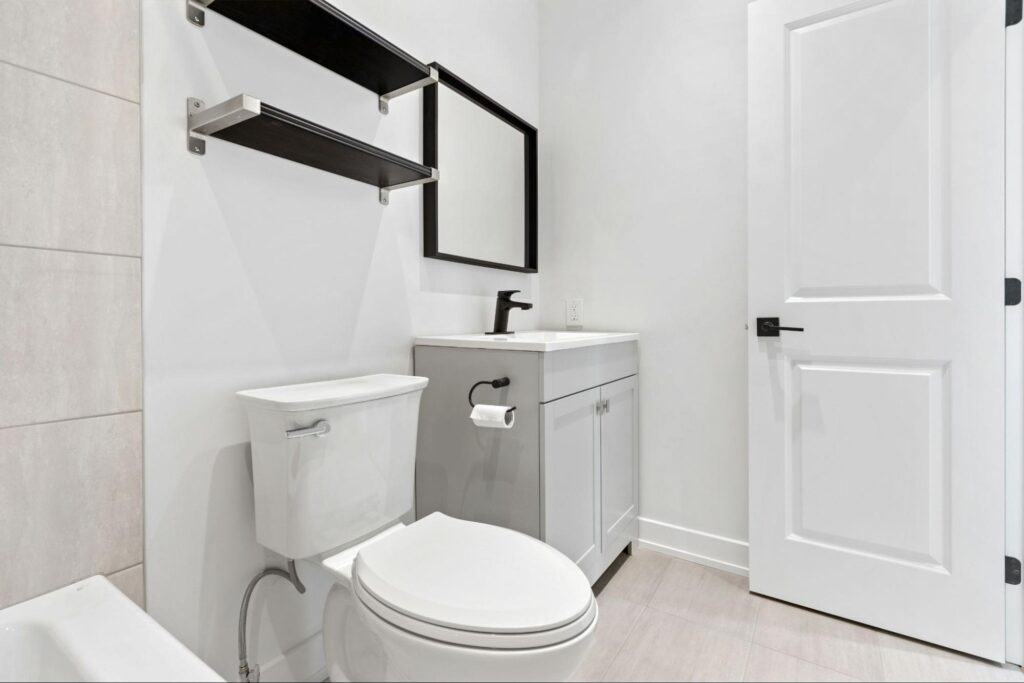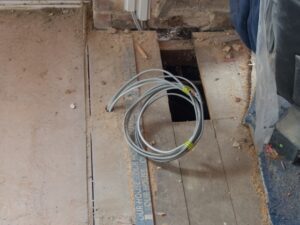We’ve all been there: a toilet that simply won’t flush can be both frustrating and inconvenient. But before you start stressing, try a few quick checks.
Often, the culprit is something simple like a clogged toilet, a low water level in the tank, or a malfunctioning flapper. These are all issues you can typically fix on your own without needing a plumber.
First, grab a plunger—it might just be all you need to clear a minor blockage and restore normal flushing. If that doesn’t solve the problem, it could be as simple as adjusting the water level in the tank or fixing a faulty flapper.
These basic troubleshooting steps can save you time and hassle, and might even keep you from needing a plumber altogether.
But, what if the problem persists?
Sometimes, there could be more complex issues like mineral buildup or a malfunctioning fill valve causing the trouble. If basic fixes don’t work, it’s probably time to bring in an expert.
That’s where Excel Mechanical comes in. Known for our top-notch HVAC and plumbing services, we offer professional care focusing on quality and value. Whether you’re dealing with a stubborn toilet at home or need commercial plumbing help, we tailor our services to meet your needs and budget.
With our team handling your plumbing, you can rest easy knowing that the job will be done right the first time—saving you time, money, and headaches in the long run.
In this blog, you will learn:
- How to troubleshoot a toilet that won’t flush.
- The most common causes behind flushing issues.
- When it’s time to call a professional plumber for expert help.
Let’s get started!
Immediate Actions to Take
When your toilet won’t flush, you can quickly try a few things before calling for professional help. Start by examining the flush handle, checking the water level in the tank, and attempting to clear minor blockages.
Check the Flush Handle
First, check if the flush handle is working properly. Sometimes, the handle becomes loose or disconnected from the toilet’s internal parts.
Gently lift the lid off the tank and observe the handle mechanism. You may find that the chain connecting the handle to the flapper is disconnected or too slack. If so, reattach the chain or adjust it so there’s a slight tension when the handle is in a neutral position.
Ensure that the handle is not corroded or damaged. If it appears faulty, a simple handle replacement from a hardware store should resolve the issue. A functioning flush handle is crucial, so addressing this first can often fix the problem immediately.
Inspect the Water Level in Tank
Next, check the water level inside the tank.
Remove the tank lid carefully and note the water level. If the water level is below the fill line, your toilet might not flush properly. You can adjust the water level by changing the float position.
If you have an older model with a ball float, adjust the ball float upward. Adjust the cylinder height according to the manufacturer’s guide for newer toilets with a cylinder float. Ensure the water reaches the fill line after refilling the tank. This adjustment can make your toilet flush with the right pressure.
Clearing Minor Blockages
If the flush handle and water level seem fine, there might still be a minor blockage. Use a plunger to try to clear any small clogs in the drain.
Firmly position the plunger over the toilet bowl’s drain hole, ensuring a good seal around the edges. Push down and pull up on the plunger handle several times, releasing the suctioned air and water to dislodge clogs.
Repeat this process a few times if necessary. You might need a plumbing snake to reach further down the pipe for more stubborn blockages. If problems persist or seem severe, consider contacting Excel Mechanical for assistance.
Diagnosing Flush Mechanism Issues
When your toilet won’t flush properly, it’s crucial to check the flush mechanism. The flapper valve, lift chain, and handle mechanism are key areas to investigate. Each component plays a vital role in ensuring a smooth and efficient flush.
Flapper Valve Inspection
The flapper valve is located at the bottom of the toilet tank and controls the release of water into the bowl. Inspect the flapper to ensure it isn’t warped or blocked. A damaged flapper can cause leaks or insufficient water release.
If the flapper is worn or looks damaged, it might need to be replaced. Make sure it seals completely when the tank refills. A tight seal prevents water from leaking. Adjusting the flapper’s alignment can also solve the issue.
Lift Chain Adjustment
The lift chain links the toilet handle to the flapper valve.
If it’s too loose or too tight, flushing problems can occur. Check the chain’s tension by examining if it allows the flapper to open fully when flush.
If the flapper doesn’t lift properly, try adjusting the chain length. Shorten it if it’s too loose, or lengthen it if it’s too tight. Ensuring the chain’s correct adjustment can significantly improve flush performance.
Handle Mechanism Assessment
The handle mechanism might also be the culprit when your toilet won’t flush.
Test the handle by pressing it and observing if it moves smoothly and returns to its resting position. If it feels loose or stuck, the internal components might need attention.
Tightening or replacing the handle assembly could resolve flush issues. The handle’s connecting parts inside the tank often wear out or misalign over time. Keeping these parts in good condition ensures reliable flushing and prevents minor issues from escalating.
Proper maintenance and timely adjustments can extend the toilet’s lifespan without needing extra parts.
Addressing Clogs
When your toilet won’t flush, it might be due to a clog. You can use simple tools or eco-friendly methods to clear these blockages. With the right approach, you’ll solve the problem efficiently and effectively.
Using a Plunger
A plunger is a handy tool for clearing clogs.
First, ensure there’s enough water in the toilet bowl. This will help create a seal. Place the plunger over the hole, and move it up and down firmly.
Apply steady pressure for the most impact. If the water starts to drain, it may mean the clog is clearing. Repeat the plunging action several times if necessary. Afterward, flush the toilet to see if the blockage is gone.
Applying a Toilet Auger
A toilet auger might be needed for stubborn clogs.
Insert the auger gently into the toilet, turning the handle slowly to reach the blockage. Be careful not to scratch the toilet bowl while doing this. The auger should break through or grab onto the clog, allowing you to pull it out.
Once it’s done, flush the toilet to check if normal flow is restored. This method is effective for material lodged deeper in the plumbing.
Eco-Friendly Solutions
Eco-friendly options can clear your toilet without chemicals.
Use a mixture of hot water and dish soap. Pour the mixture into the bowl and let it sit. The heat and soap can soften and dislodge minor clogs. Baking soda and vinegar are another option. Add them to the toilet and watch for fizzing, which helps break down clogs.
If you’re unsure or the problem persists, consider professional help. Excel Mechanical offers high-quality HVAC and plumbing services. Our team can find solutions tailored to your needs and budget. Trust us to deliver excellent service every time.
Water Supply Concerns
The problem might be with the water supply if your toilet won’t flush. Two areas to inspect are the shut-off valve and the waterline. Addressing these can help restore proper function to your toilet.
Evaluating the Shut-Off Valve
The shut-off valve controls water flow to your toilet.
To check it, locate the valve beneath the toilet tank. You should see a handle or knob which turns the water on or off.
Turn the valve counterclockwise to ensure it is fully open. This could be the issue if it’s stuck or hard to turn. A partially closed valve can reduce water flow, preventing the toilet from flushing properly.
Sometimes, the shut-off valve may need replacement, especially if it’s old or corroded.
Look for signs of wear or leaks. If you suspect a problem, it may be time to contact a plumber for assistance. These tasks sometimes require professional help to ensure they are done correctly.
Checking for Waterline Issues
Waterline problems can also cause flushing issues. Start by inspecting the water supply line connecting the shut-off valve to the toilet tank. Look for kinks, bends, or damage in the line.
Listen for unusual sounds, such as hissing or gurgling, that might indicate a leak. A leaking waterline can reduce water pressure, affecting the flush mechanism. Tightening the connections might resolve minor issues, but if the damage is significant, a full replacement may be necessary.
Advanced Troubleshooting
More advanced issues could be at play when your toilet won’t flush. Focus on key areas like the siphon jet and the vent pipe to effectively identify and resolve these complex problems.
Siphon Jet Maintenance
The siphon jet helps create the necessary suction for flushing. If it is clogged, flush performance diminishes. Use a mirror to inspect and confirm if there’s buildup or blockages. Regular cleaning with a brush and mild soap can often resolve minor issues.
Combining baking soda and vinegar can help clear more stubborn debris for tougher buildup. Pour a cup of baking soda, followed by a cup of vinegar into the toilet bowl. Let it sit for about half an hour, then flush.
If maintenance doesn’t resolve the issue, a deeper cleaning may be necessary, possibly requiring professional services.
Vent Pipe Obstructions
The vent pipe, crucial for proper drainage, can become blocked by leaves, debris, or even small animals. This blockage causes low water pressure and weak flushes. Access your roof and visually inspect the vent pipe’s opening for any visible obstructions.
Using a plumber’s snake, carefully insert it into the vent pipe to dislodge any blockages.
Run water through a hose into the pipe to clear the remaining debris. Exercise caution when dealing with roof and plumbing work to prevent unexpected damage or injury.
Professional Help
Seeking professional assistance can ensure your plumbing issues are resolved efficiently and safely. Knowing when to call in an expert can save you time and prevent further damage to your plumbing system.
When to Call a Plumber
If your toilet won’t flush despite attempts to unclog it with a plunger or snake, it’s time to consider professional help. Persistent blockages might indicate deeper issues like sewer line problems or pipe damage.
Frequent clogs, odd noises, and unpleasant smells suggest something is wrong. If water rises in unexpected places, such as sinks or tubs, it might also mean a significant blockage. In these cases, a plumber can diagnose and fix the problem effectively.
Finding the Right Professional
Choosing the right plumber ensures the job is done correctly.
Look for professionals with strong reputations and positive reviews. Verify their credentials and experience, especially with similar problems.
Excel Mechanical offers exceptional quality and great value for HVAC and plumbing services. We tailor our approach to fit your needs and budget, making them an excellent choice for all your plumbing requirements.
Selecting a reliable expert protects your home from future plumbing issues and ensures long-lasting solutions.
Prevention and Maintenance
Keeping your toilet in top shape can prevent future headaches.
Simple habits like regular cleaning and routine inspections can go a long way. These practices help avoid common issues like clogs and leaks, ensuring your toilet works smoothly.
Regular Cleaning
Cleaning your toilet regularly is key to keeping it functioning well. A clean toilet reduces the buildup of grime and mineral deposits that cause clogs. Use a toilet brush and cleaner at least once a week.
Steps for Cleaning:
- Apply Toilet Cleaner: Squirt under the rim and let it sit for 5-10 minutes.
- Scrub with a Brush: Focus on the bowl and under the rim.
- Flush the Toilet: Rinse away the cleaner by flushing.
Cleaning helps prevent unpleasant odors and keeps parts like the flush valve from wearing out too soon. This also keeps your bathroom sanitary and inviting. Regular maintenance ensures your toilet remains reliable over time.
Routine Inspections
Regular inspections help catch problems early. Add a few drops of food coloring to the tank to check for leaks. If it appears in the bowl after 10 minutes, there’s a leak.
Inspection Tips:
- Check the Handle: Ensure it moves freely without sticking.
- Look at the Flapper: Make sure it seals properly.
- Inspect the Fill Valve: See if it refills correctly without overflows.
Routine checks allow you to fix minor issues before they become major repairs. Attention to these aspects keeps your toilet and plumbing system in optimal condition.
For expert help, Excel Mechanical offers top-quality HVAC and plumbing services. We balance good value and tailored systems for each client—whether residential or commercial.
Frequently Asked Questions
We know how frustrating plumbing issues can be, especially when your toilet won’t flush properly. But don’t worry—you’re not alone. Here are some common questions and answers to help you troubleshoot and find the solution that works for you:
Why does my toilet not flush when the handle is loose?
A loose handle may mean the chain inside the tank isn’t properly connected. Check if the chain has come off the flush lever. Then, adjust or reattach it so that there’s little slack.
How can I fix a toilet that fills up with water and drains slowly?
A partial blockage in the drain could cause a slow-draining toilet. Try clearing it with a plunger. If this doesn’t work, you might need a plumber’s snake to remove deeper clogs.
What should I do when the toilet won’t flush, and there’s no water in the tank?
No water in the tank could be due to a problem with the water supply valve. Make sure the water valve is fully open. If it is and the issue persists, there might be an issue with the float or the fill valve.
How do you unblock a toilet that won’t flush, even though it’s not clogged?
If the toilet isn’t clogged but still won’t flush, the problem might be with the flapper. Check if the flapper is sealing the flush valve correctly. If necessary, replace it to ensure a tight seal.
What are the steps to resolve a toilet that won’t flush all the way?
Insufficient water entering the bowl can cause inconsistent flushing. Check the tank’s water level and adjust the float if it’s too low.
What to do if the toilet bowl water rises but does not flush?
Water rising without flushing might indicate a venting issue. Ensure the vent stack isn’t blocked by debris or a bird’s nest.




